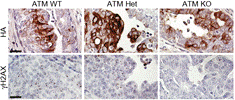Veterinary and Biomedical Sciences, Department of
Date of this Version
2005
Document Type
Article
Citation
Published in The Journal of Immunology 175:9 (2005), pp. 5591-5595; doi: 10.4049/ jimmunol.175.9.5591
Abstract
Female B10.S mice are highly resistant to proteolipid protein (PLP) 139–151-induced experimental autoimmune encephalomyelitis (EAE) and depletion of PLP 139–151- reactive CD4+CD25+regulatory T (Treg) cells can slightly increase their EAE susceptibility. Although male B10.S mice are moderately susceptible to EAE, we report that depletion of Treg cells in male B10.S mice before immunization with PLP 139–151 renders them highly susceptible to severe EAE with more CNS neutrophil infiltrates than nondepleted controls. Increased susceptibility is associated with an enhanced PLP 139–151-specific T cell response and greater production of IFN-γ, IL-6, and IL-17. Male CD4+CD25+ effector cells depleted of Treg cells proliferate to a greater degree than those from females in response to either anti-CD3 or PLP 139–151. These data suggest that because of their capacity to regulate potent autoaggressive effector cells, Treg cells partly contribute to the resistance to autoimmunity in the male mice.
Included in
Animal Diseases Commons, Cell and Developmental Biology Commons, Comparative and Laboratory Animal Medicine Commons, Immune System Diseases Commons, Immunology and Infectious Disease Commons, Veterinary Infectious Diseases Commons, Veterinary Microbiology and Immunobiology Commons, Veterinary Pathology and Pathobiology Commons


Comments
Copyright © 2005 by The American Association of Immunologists, Inc. Used by permission.